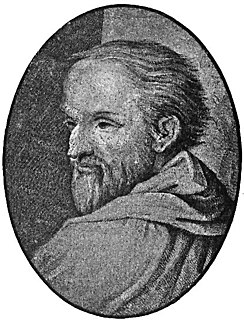
Antonio Allegri da Correggio, usually known as just Correggio, was the foremost painter of the Parma school of the High Italian Renaissance, who was responsible for some of the most vigorous and sensuous works of the 16th century. In his use of dynamic composition, illusionistic perspective and dramatic foreshortening, Correggio prefigured the Baroque art of the 17th century and the Rococo art of the 18th century. He is considered a master of chiaroscuro.

Girolamo Francesco Maria Mazzola, also known as Francesco Mazzola or, more commonly, as Parmigianino, was an Italian Mannerist painter and printmaker active in Florence, Rome, Bologna, and his native city of Parma. His work is characterized by a "refined sensuality" and often elongation of forms and includes Vision of Saint Jerome (1527) and the iconic if somewhat untypical Madonna with the Long Neck (1534), and he remains the best known artist of the first generation whose whole careers fall into the Mannerist period.

San Giovanni Evangelista is a church in Parma, northern Italy, part of a complex also including a Benedictine convent and grocery.
(The) Mystic(al) Marriage of Saint/St. Catherine may refer to any of a large number of paintings of the Mystical marriage of Saint Catherine, a few of which are:
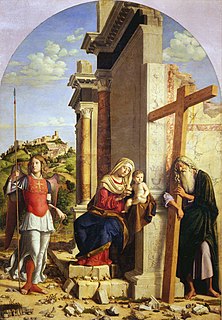
The Madonna and Child with Saints Michael the Archangel and Andrea is a Cima da Conegliano painting oil on panel dating from c. 1496-1498, and preserved at the Galleria nazionale di Parma.
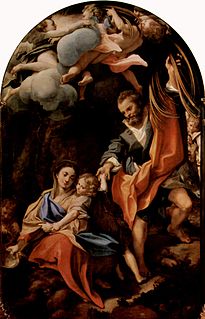
Madonna della Scodella is an oil painting on panel by Antonio da Correggio, dated from 1528 to about 1530 and preserved at the Galleria nazionale di Parma.

The Madonna of the Stairs is a fresco fragment by Correggio, dating to around 1522-1523 and now in the Galleria Nazionale di Parma.

The Annunciation is a 157 by 315 cm fresco fragment by Correggio, dating to around 1524-1525 and now in the Galleria nazionale di Parma.

The Mystic Marriage of St Catherine is a c.1529 oil on panel painting of the mystical marriage of Saint Catherine by Parmigianino, now in the National Gallery, London, who acquired it in 1974. It was engraved by Giulio Bonasone.

Healing of the Man Born Blind is a c.1573 painting by El Greco, showing the healing the man blind from birth. It is now in the Galleria nazionale di Parma. It is signed at the bottom right-hand corner. It shows the artist returning to a theme he had first painted five years earlier, in a work now in Dresden.

Pope Paul III with a Nephew is an unfinished 1534 oil on slate portrait by Sebastiano del Piombo, now in the Galleria nazionale di Parma. The nephew's identity is unclear but the painting's presumed date suggests it may be Ottavio Farnese, whom Pope Paul III made Duke of Parma and Piacenza soon after the work's date

Deesis with Saint Paul and Saint Catherine is an oil on panel painting by Giulio Romano, executed c. 1520, now in the Galleria nazionale di Parma. Its title refers to deesis, a subject in Christian iconography, shown here with Paul of Tarsus and Catherine of Alexandria in the lower register and the Virgin Mary and John the Baptist in the upper.

Portrait of a Young Man is an oil on panel painting by Parmigianino, executed c. 1530, now in the Uffizi in Florence, whose collection it entered on 27 October 1682. Three copies survive in the Museo di Capodimonte, Rome's Accademia di San Luca and the Galleria nazionale di Parma.

Portrait of a Man in a Red Beret or Self-Portrait in a Red Beret is a oil on paper painting attributed to Parmigianino or Michelangelo Anselmi, executed c. 1540, now in the collection of the National Gallery of Parma.
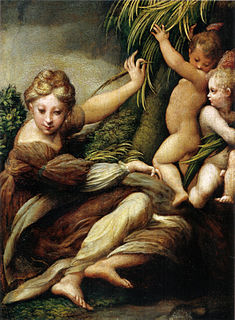
Female Martyr with Two Angels is a c.1523-1524 oil on panel painting by Parmigianino, now in the Städel Museum in Frankfurt, to which it was donated in 1913 by Baroness Emilie Margarethe Beaulieu-Marconnay, member of a family of bankers and art patrons in the city.
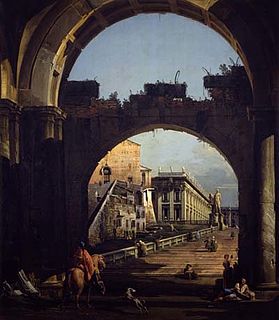
Capriccio with the Campidoglio is a c. 1742 oil on canvas painting by Bernardo Bellotto. It was acquired by count Stefano Sanvitale di Parma in 1835 and then exhibited in the Galleria nazionale di Parma, where it now hangs alongside another painting originally produced as its pendant.

The Funeral of the Virgin Mary is a 1605-1609 oil on canvas painting by Ludovico Carracci, now in the Galleria nazionale di Parma.

Self-Portrait is a 1593 oil on canvas painting by Annibale Carracci, now in the Galleria Nazionale di Parma. It is dated 17 April 1593 on the top left of the canvas.

Pietà with Saints Clare, Francis and Mary Magdalene is a 1585 oil on canvas painting by Annibale Carracci, now in the Galleria nazionale di Parma.

Madonna and Child with Saints is a 1586 oil on canvas painting by Agostino Carracci, dated on the lowest step of the Virgin Mary's throne. An example of a sacra conversazione. Long in the Benedictine abbey of San Paolo in Parma, French troops took it to Paris in 1796 and on its return to Italy in 1816 it was moved to the Galleria nazionale di Parma, where it still hangs.



















